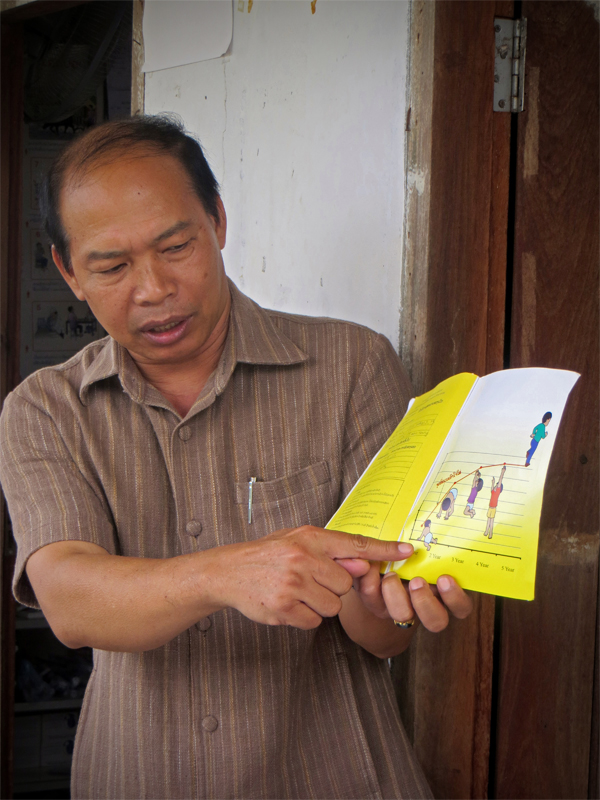
A Day in the Life of a Pretest: Applying CapacityPlus’s New Health Worker Productivity Tool
An important part of any field test of a new tool is to pretest the data collection instruments to ensure they are easy-to-use and comprehensible, as well as to provide hands-on experience and practice for the data collectors.
Our pretest is in Pakgneum District, about an hour’s drive from Vientiane, the capital of the Lao People’s Democratic Republic (PDR). Our team is led by Dr. Loun Manivong, deputy director of the Lao PDR Ministry of Health’s Department of Health Personnel.
When we arrive, we are warmly welcomed by the director of the district hospital and the staff. They are pleased to be selected to support the Ministry in its field test of CapacityPlus’s new Productivity Diagnostic and Improvement Toolkit.
Building capacity for assessing health worker productivity
I have been fortunate to work closely with the Ministry of Health’s Department of Health Personnel over the last few years to support its efforts to strengthen the health workforce and increase access to quality health services.
And now, also in collaboration with the World Health Organization/Lao PDR, CapacityPlus is helping to build the capacity of the Ministry to assess health workforce productivity at health facilities, diagnose the causes of productivity challenges, and determine the most appropriate interventions to address the challenges.
While most efforts to address the global health workforce crisis aim to increase the numbers of available health workers, it is also important to pay attention to health worker productivity. Increasing the efficiency of service delivery and improving the productivity of currently available health staff will help maximize health system performance. Unless any productivity issues are adequately resolved, newly produced health workers will enter into weak systems and perpetuate low productivity, under-performance, and inefficient service delivery.
Back to the pretest
After introducing ourselves at the district hospital, our team divides into two groups to visit two different health centers in the district to test the focus group discussion guides (one for community members and one for health workers).
It is heartwarming to see all the community women (and their children) who answered the district’s call to participate in the focus group discussion and provide their input regarding health service provision. Chief among their suggestions are to post more health workers at the facility—if the sole nurse is conducting outreach for immunizations or other prevention activities, the facility will be closed for the day—as well as improve the equipment and supplies for pregnancy-related services.
We also interview the nurse who works at the facility to understand her perspectives regarding patient demand, health worker availability, and service provision.
 While waiting for the interview to finish up, Dr. Loun Manivong, never forgetting his roots as a health professional and the importance of primary care, uses the time to conduct health promotion and talk with the women about nutrition, immunizations, and seeking health care when they feel ill.
While waiting for the interview to finish up, Dr. Loun Manivong, never forgetting his roots as a health professional and the importance of primary care, uses the time to conduct health promotion and talk with the women about nutrition, immunizations, and seeking health care when they feel ill. We return to the district hospital to meet back up with the other team, and test the health worker flow mapping tool. Fortunately, there are some patients left at the district hospital, and we observe how the health workers move about and use their time during service delivery.
Before we head back to Vientiane our two teams meet to discuss our experiences and lessons learned from the pretest, as well as to provide suggestions on how to improve the wording and flow of the data collection tools and tips for implementing the approach at other health facilities.
The next steps
As this experience has demonstrated, building in time and resources to conduct a pretest is an essential component of the development of any new methodology. We will incorporate the lessons learned from application of the methodology in Lao PDR into a final version that will be broadly disseminated to assist other countries in similar quests.
Stay tuned for part two of the story in July when the Ministry completes the field test of the Productivity Diagnostic and Improvement Toolkit in the province of Bolikhamxay, with the participation of three of its district hospitals and 12 health centers.
Help CapacityPlus spread the word about strengthening the health workforce. Follow us on Twitter and like us on Facebook .
Related items:
Photos by Wanda Jaskiewicz



